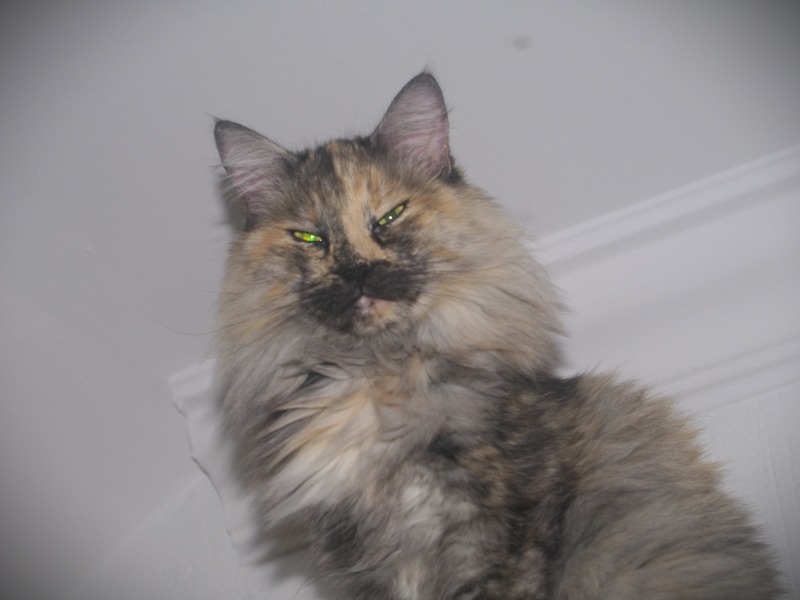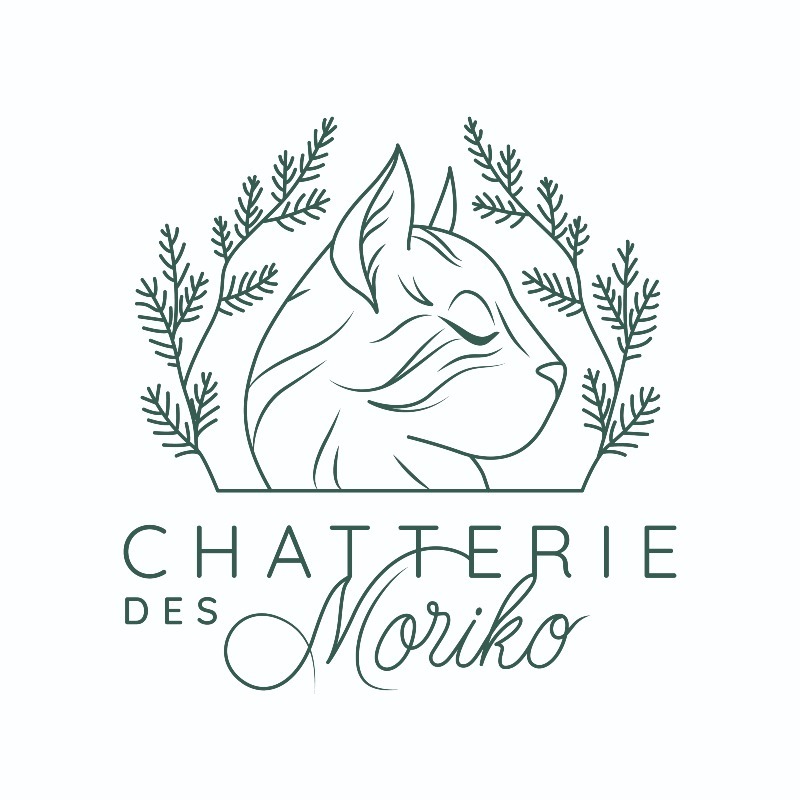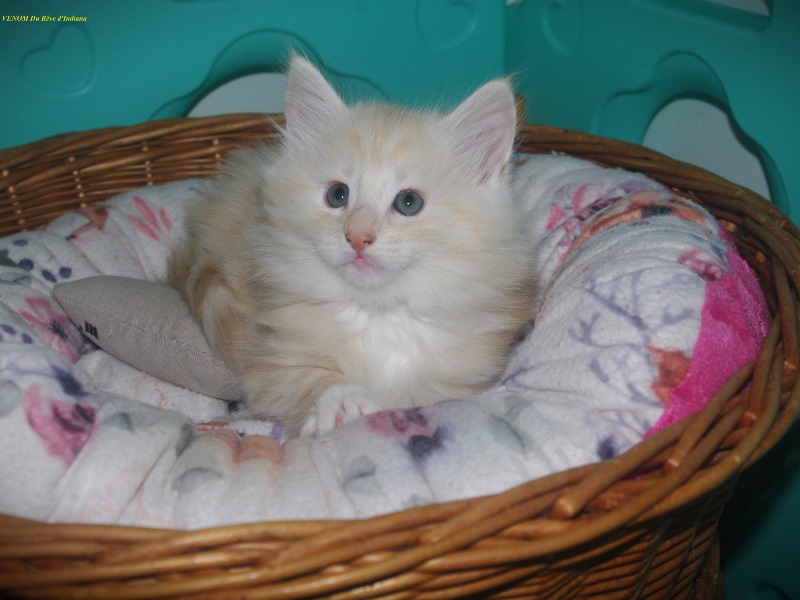Norwegian forest cat
Welcome to our page dedicated to the breed of cat norwegian forest cat!
Here, you will find all the useful information about norwegian forest cat. This descriptive profile will allow you to discover the aspects of this breed. You can notably consult information about the average price, monthly and annual upkeep expenses, their health, name ideas, as well as their official recognition by competent authorities.
Explore this page to discover everything you need to know.
Overall description of the breed
The Norwegian Forest Cat is one of the only breeds that has not undergone human selection in its evolution, making it a remarkable example of natural selection at work. It is so common in Norway that it could be nicknamed the Norwegian gutter cat.
Extremely resistant to the cold thanks to its thick fur, it is equipped to brave the harshest climates, while also tolerating the heat. Enthusiasts of the 'Norsk Skogatt', as it is known in Norway, believe that this breed may have developed its abundant coat as a result of various natural crosses with Persians and local cats, or perhaps even a genetic mutation specific to the Norwegian Forest Cat that has caused its genetic make-up to evolve.
The Norwegian Forest Cat is a large cat, with adult males weighing up to 9kg. Despite their rather imposing size, they are extremely friendly and often need human contact, being very close to their owner. It's an affectionate and peaceful cat, which makes it an ideal companion!
Norsk Skogatt", which translates as "Northern Forest Cat", is one of the oldest breeds of cat, and was first documented in the 17th century. Mainly present in Norway, it suffered the disasters of hyperconsanguinity in the 1950s due to the export ban, but it regained its letters of nobility in the 1970s, when it was officially recognised as a breed.
Norwegian Cats are robust and powerful, and are very good hunters, able to fend for themselves and adapt to their environment fairly easily, even in very cold weather. They are fairly independent cats, tolerating solitude well, but they also enjoy the company of humans, although the latter must respect their sometimes insubordinate feline status.
Nevertheless, they remain good family cats and know how to be tender with their owners. Its adult weight is between 6 and 8 kg (13 and 17 lb), but larger cats can reach up to 10 kg (22 lb).
Awareness of acquiring an animal
Each animal is a sensitive being, deserving love, attention and care.
When you choose to adopt an animal, you take on the responsibility of ensuring its health and well-being throughout its life.
To learn more about animal welfare, we invite you to consult our FAQ by clicking the button below:
Origins
The Norwegian Forest Cat, also known as "Norsk Skogkatt", is a natural breed originating from Norway. This sturdy cat is perfectly adapted to the rigors of the Nordic climate. Norwegian legends speak of large cats living in the forests, often associated with Viking myths. Norwegian Forest Cats likely evolved from domestic cats brought by the Vikings over a thousand years ago. Their thick, waterproof fur and dense undercoat testify to their adaptation to harsh winters. They have developed impressive hunting skills, making them valuable companions for farmers. Their ability to survive in extreme conditions has favored their natural selection, giving rise to a robust, independent breed well-suited to outdoor life.
History
The history of the Norwegian Forest Cat is closely linked to Scandinavian tales and traditions. This majestic cat is mentioned in Norwegian fairy tales and Norse mythology. According to legend, it was the companion of the goddesses Freyja and Thor. At the beginning of the 20th century, the breed almost disappeared due to crossbreeding with other domestic breeds. Fortunately, in the 1930s, Norwegian breeders began to preserve the breed by selecting cats with typical characteristics of the Norwegian forests. The official recognition of the breed by the International Feline Federation (FIFe) took place in 1977. Since then, the Norwegian Forest Cat has gained popularity worldwide, appreciated for its wild beauty and affectionate nature.
Standard
The standard of the Norwegian Forest Cat breed highlights its robustness and majestic appearance. This cat is large with a strong skeleton and powerful musculature. The head is triangular with a straight profile, expressive almond-shaped eyes and large ears placed high and well-furnished with fur. The coat is dense, with a double layer: a woolly undercoat and a longer outer layer of waterproof fur. The ruff and tail, well-furnished, add to its majestic appearance. The standard allows for a wide range of colors and patterns, with the exception of chocolate, lilac, cinnamon and fawn. The legs are long, with large, round feet, well-furnished with fur to protect them from winter conditions.
Physical characteristics
The Norwegian Forest Cat is a large feline. Males can weigh between 5 to 9 kg, while females are generally lighter, weighing between 3.5 and 7 kg. Their body is elongated and muscular, with slightly longer hind legs than forelegs. The coat is long and double: a dense and woolly undercoat protects from the cold, while the outer layer is longer and waterproof. The colors of the coat vary widely, including shades of black, white, blue, red, cream, with different patterns such as tabby, tortie or bicolor. The tail is long and bushy, adding to their majestic appearance. The eyes are large, almond-shaped, and can be of different colors, often green, gold or copper.
Character
The Norwegian Forest cat is known for its gentle and balanced temperament. They are affectionate without being intrusive, enjoying the company of their owners while being able to entertain themselves. They are curious, intelligent, and have a strong hunting instinct, making them lively and playful. Their sociable nature makes them friendly with other animals and patient with children. Although they are independent, they appreciate moments of tenderness and love to perch high to observe their surroundings. Their voice is soft and melodious, often communicating with trills and light meows. In short, the Norwegian Forest cat is a loyal, loving, and balanced companion.
Life expectancy
The Norwegian forest cat generally enjoys good health and a long lifespan. On average, these cats live between 12 and 16 years, some even reaching 18 years or more with proper care. Their natural robustness and adaptation to difficult climatic conditions contribute to their longevity. To maximize their lifespan, it is essential to provide them with a balanced diet, regular veterinary care, and a stimulating environment. Veterinary check-ups can detect and treat potential diseases early, increasing their chances of a long and healthy life. An active lifestyle and good hygiene are also key factors in ensuring their well-being and longevity.
Exercise and activity needs
The Norwegian Forest Cat is an active and playful animal, requiring a stimulating environment to thrive. They love climbing, exploring, and hunting, so offering cat trees, shelves, and interactive toys is essential. Their hunting instinct can be satisfied with games that imitate hunting, such as fishing rods or balls. Although they can adapt to apartment living, they are happier with secure outdoor access where they can climb and run. Mental stimulation, such as food puzzles, is also beneficial. These activities keep them in shape and prevent boredom, reducing the risks of destructive behaviors.
Recommended diet
The diet of Norwegian forest cats should be balanced and high in protein to support their large size and energy levels. It is recommended to feed them high-quality food, mainly composed of meat or fish, with essential nutrients such as omega-3 and omega-6 fatty acids. Dry kibble and specially formulated wet food for large breeds are ideal. A mixed diet, combining dry and wet food, can benefit their digestive and dental health. The monthly cost of food ranges from 30 to 60 euros, depending on the brand and quality of the products chosen. It is also important to ensure their hydration by always providing them with fresh and clean water.
Training and obedience
The education of Norwegian Forest cats should start at a young age to establish good habits and strengthen the bond with their owner. These cats are intelligent and responsive to training, especially when it is based on positive reinforcement techniques. Using treats and praise to reward desired behaviors is very effective. Learning to use the litter box, not to scratch furniture, and responding to their name are essential basics. Interactive games can also be used to teach simple tricks like sitting or shaking paws. Their hunting instinct and natural curiosity make it easier to introduce new activities and toys, making education fun and engaging.
Behavior with children
The Norwegian Forest cat is known for its gentle and patient behavior, making it an excellent companion for children. They are generally tolerant and enjoy human company, including the youngest family members. Their playful and active nature fits well with children's energy, and they are often happy to participate in games. However, it is important to supervise interactions between young children and the cat to ensure that the animal is not handled inappropriately. Teaching children to respect the cat's needs and limits is crucial for establishing a harmonious and safe relationship between them.
Compatibility with Other Animals
The Norwegian Forest cat generally gets along well with other pets, including dogs and other cats. Their sociable nature and balanced temperament allow them to adapt to the presence of new companions, as long as introductions are made gradually and with caution. It is important to monitor the initial interactions to ensure that all animals feel safe and respected. Supervised play sessions and the use of calming pheromones can help facilitate adaptation. Over time, the Norwegian Forest cat can form strong bonds with its animal companions, creating a harmonious and happy home environment.
Grooming needs
The Norwegian Forest Cat has a beautiful coat that requires regular care to stay healthy and prevent knots. Weekly brushing is usually enough to remove dead hair and prevent hairballs. However, during shedding periods, in spring and fall, more frequent brushing may be necessary. Using a long-haired brush or a metal comb can help detangle the dense undercoat. It is also important to regularly check the ears, eyes, and teeth, and clean them if necessary. Claws should be trimmed regularly to prevent them from becoming too long.
Health
The Norwegian Forest Cat is generally healthy and robust, but like all breeds, it can be prone to certain genetic conditions. The main health concerns include hypertrophic cardiomyopathy, a heart disease, and type IV glycogen storage disease, a rare metabolic disorder. Responsible breeders often test their breeding cats for these conditions to minimize risks. A balanced diet, regular exercise, and regular veterinary visits are essential to maintain the health of these cats. Vaccinations, parasite treatment, and regular dental care are also necessary preventive healthcare to ensure a long and healthy life for your Norwegian Forest Cat.
Average price
The price of a Norwegian Forest kitten can vary depending on several factors, including lineage, breeder reputation, and the specific characteristics of the kitten. Generally, the average cost of a kitten of this breed is between 800 and 1500 euros. Kittens from champion lines may be more expensive, sometimes reaching 2000 euros or more. This price often includes first vaccinations, deworming, and sometimes sterilization. It is recommended to choose reputable breeders who provide pedigree documents and health guarantees, even if it means paying a little more.
Expenses
The average monthly expenses for a Norwegian Forest cat can vary depending on several factors, including food, veterinary care, and specific needs of the cat. In general, you can expect to spend between 50 and 100 euros per month. This estimate includes costs for high-quality food (30-60 euros), litter (10-20 euros), and routine veterinary care (10-20 euros). Other expenses may include toys, accessories, and parasite treatments. Additional costs may occur for exceptional healthcare or specific grooming needs.
Name ideas
Choosing a name for your Norwegian Forest cat can be a fun task. Here are some suggestions that reflect their Nordic origin and majestic character: Thor, Freya, Loki, Odin, Sif, Balder, Fenrir, Njord, Skadi, Sigrid, Harald, Astrid, Bjorn, Ingrid, Leif, Njal, Saga, Erik, Gunnar, Helga, Magnus, Solveig, Torvald, Ulf, Yngve. These names, inspired by Norse mythology and Scandinavian culture, are perfect for a cat who embodies the wild and noble spirit of Norway.
Legislation and regulation
In France, the Norwegian Forest Cat is not subject to any specific legislation or regulations outside of the general laws on pets. It is not classified as a dangerous breed and does not require a special permit. However, it is important to comply with local rules regarding the identification, vaccination, and sterilization of pets. Owners must have their cat identified by a microchip or tattoo, ensure their vaccinations are up to date, and check the specific regulations of their region or building, especially if they live in an apartment.
Official recognition
The Norwegian Forest Cat is recognized by several international feline organizations such as Fédération Internationale Féline (FIFé) and The International Cat Association (TICA). In France, the Livre Officiel des Origines Félines (LOOF) also recognizes this breed. In the United States, the Cat Fanciers' Association (CFA) and the Governing Council of the Cat Fancy (GCCF) in the UK also recognize the Norwegian Forest Cat. These organizations define the breed standards and organize feline exhibitions where Norwegian Forest Cats can compete and be awarded.
Pedigrees
To ensure an authentic pedigree, it is crucial to acquire a Norwegian Forest Cat from recognized breed clubs. In France, the Livre Officiel des Origines Félines (LOOF) is the main authority. Other recognized breed clubs worldwide include the Fédération Internationale Féline (FIFé), The International Cat Association (TICA), and the Cat Fanciers' Association (CFA) in the United States. The Governing Council of the Cat Fancy (GCCF) in the UK and the Norske Rasekattklubbers Riksforbund (NRR) in Norway are also references. These clubs ensure that registered cats meet the breed standards and come from healthy and verified lineages.
Destination and usage
The Norwegian Forest Cat is primarily intended for companionship due to its gentle and affectionate temperament. Thanks to its hunting instinct and intelligence, it can also be used in activities that stimulate mental and physical skills, such as agility courses for cats. They are often present in cat shows where their beauty and character are showcased. Due to their sociability, they are also used in animal-assisted therapy, providing comfort and companionship to people in need. Their adaptability and benevolent nature make them perfect companions for a variety of domestic environments.
Prohibitions
There are no specific prohibitions regarding the ownership or breeding of Norwegian forest cats in most countries. However, it is always important to check local regulations or restrictions in your area, especially regarding pets in general. Some residential areas or buildings may have restrictions on animals, so it is advisable to inquire with the local administration or the owners' association. Also make sure to comply with animal welfare laws and identification and vaccination requirements to ensure the health and well-being of your cat.
Breeders of Norwegian forest cat
Want to see more breeders of Norwegian forest cat?
Check out the page of our directory listing all breeders of Norwegian forest catClassified Ads of Norwegian forest cat
Want to see more ads of Norwegian forest cat?
Check out the page listing all the ads of Norwegian forest catBreed clubs of norwegian forest cat
No of norwegian forest cat breed clubs are currently registered on Preeders.
If you would like to highlight your breed club, sign up for free now and be the first to appear on this page.





